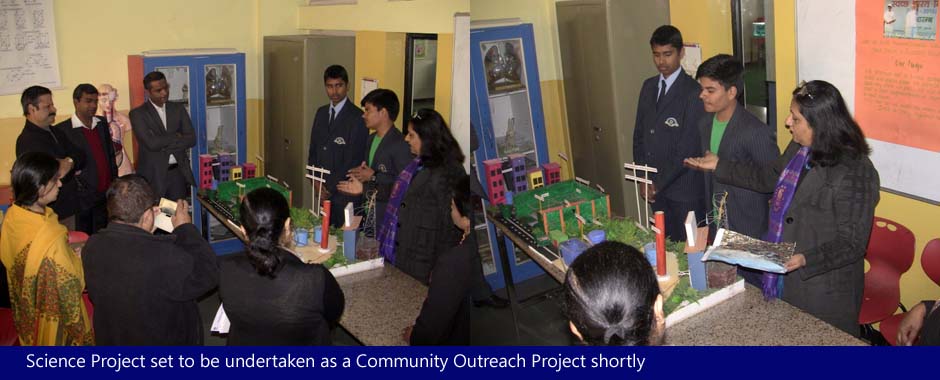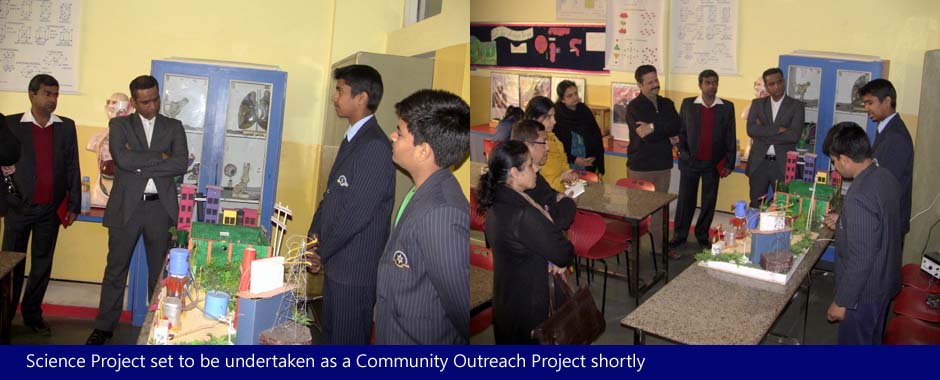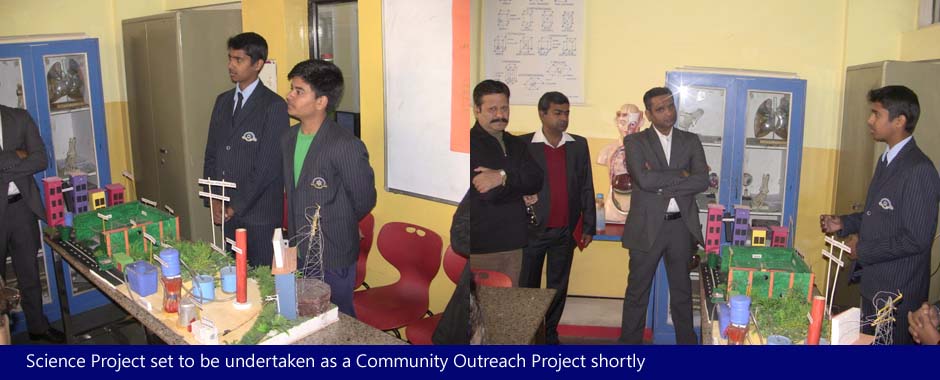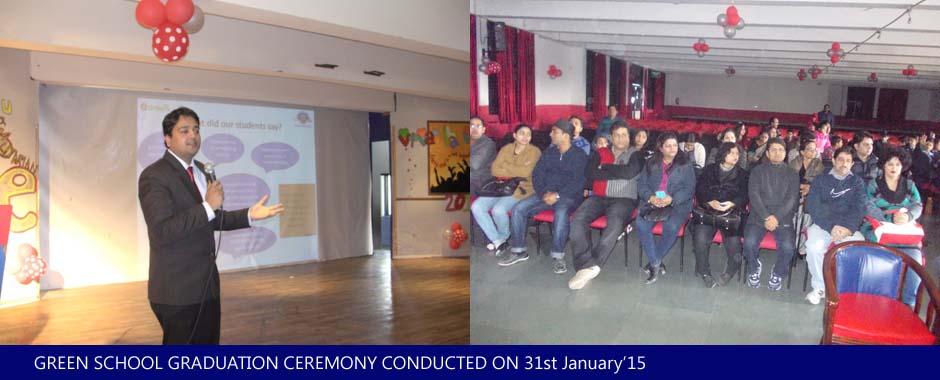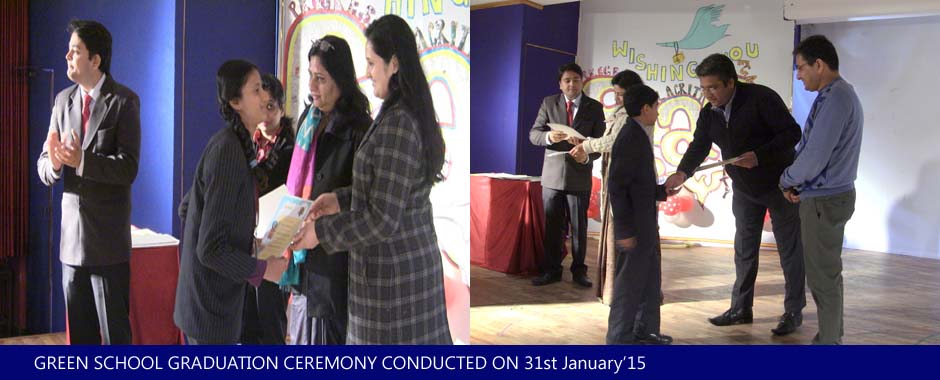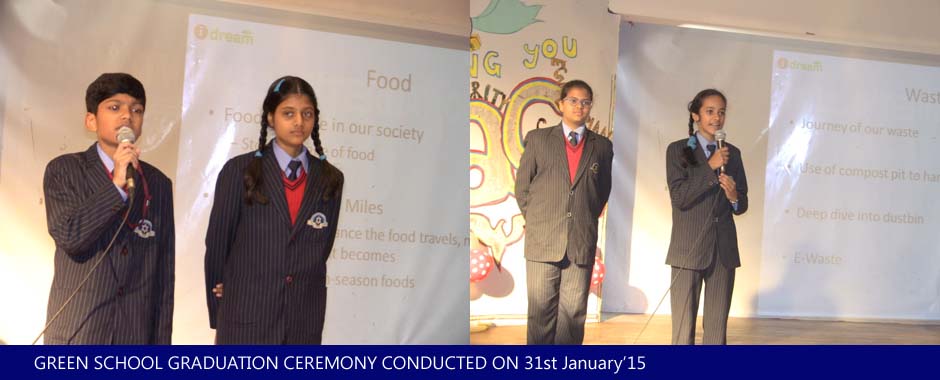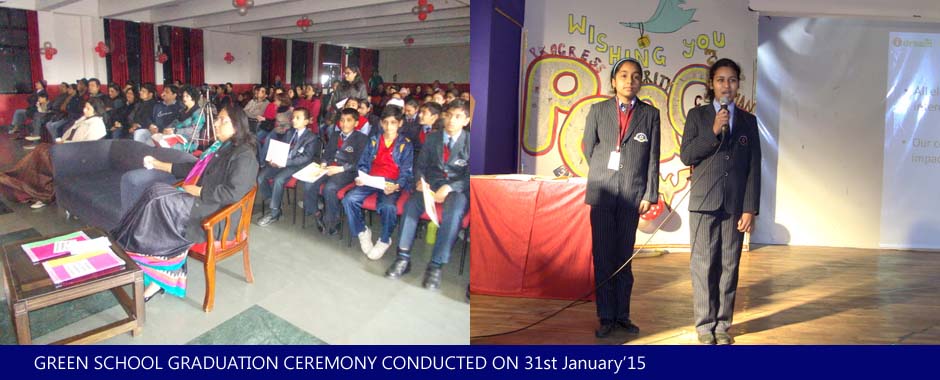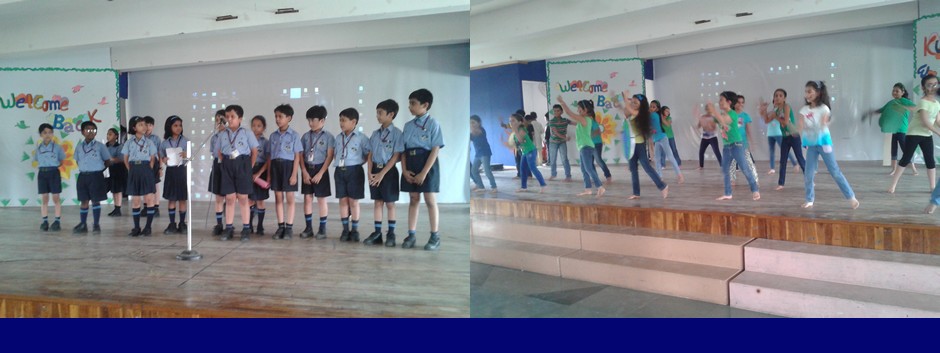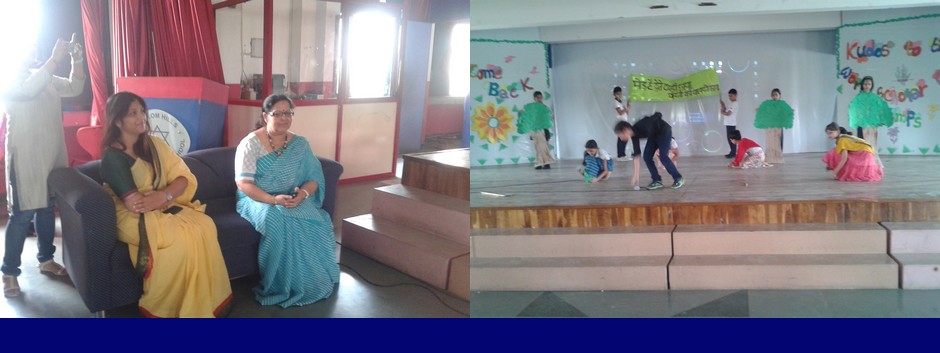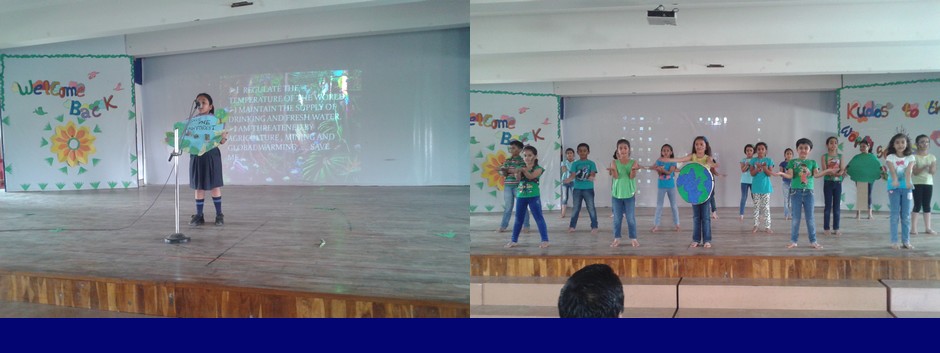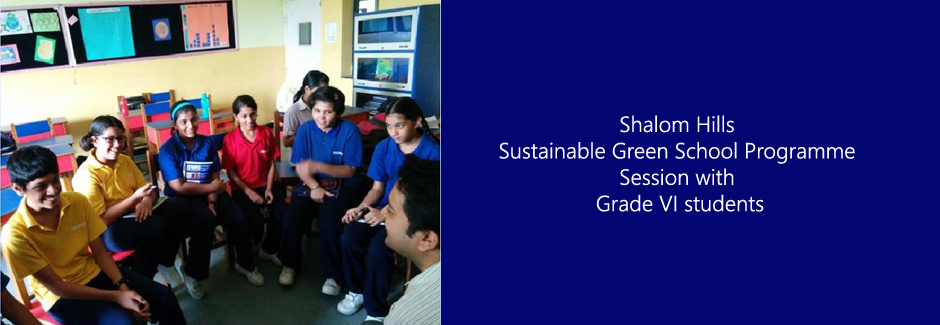Green Corner
GRADE XI STUDENTS VISIT BIODIVERSITY PARK OCTOBER 19 ,2023
An educational field trip to Tau Devi Lal Biodiversity Park was organized on October
18 ,2023 for class XI students of Shalom Hills International School . It proved to be a
remarkable experience that provided the students with an opportunity to explore the
rich flora and fauna of this natural heaven.
They explored a variety of plant species and gained insights about various kinds of
gymnosperms, their leaf modifications, roots etc. and collected various species of
flowers for their herbarium and saw different kinds of inflorescences.
The students gained interesting insights about the arrangement of reproductive
organs of the plants etc. Seed dispersion was another intriguing part of their
observations as they saw live pollination and dispersal by bees, insects and wind.
Various types of different colored insects and bugs helped them understand the
process of attraction to colorful and pompous flowers.
The experience was enriching and indeed educating since all the students were able
to learn something new about plants and their growth along with being awe struck at
the gorgeously colorful birds, which was a bonus.
‘Paudhagiri’ August 03 – 05, 2022
The students of classes VIIto X of Shalom Hills International School participatedwith full zeal and enthusiasm in the Tree Plantation initiative of the Haryana Govt. -‘Paudhagiri’.
The students were issued saplings from the school which they planted at the location of their choice and uploaded the photograph on the ‘Paudhagiri’ App. The celebration ofPaudhagiriin school was an ideal opportunity to inculcate personal and social responsibility in our students towards safeguarding trees and forests. The focus of these celebrations is towards forming a personal connect between the students and trees through a process of experience, reflection and creation.
Grade I -V'Van Mahotsav Activity' 7th July , 2022
“Trees are poems that the earth writes upon the sky.”
Van Mahotsav Week was celebrated in classes I to V from 4th July to 7TH July. It was a week long celebration which aimed at ingraining personal and social accountability in our students towards conserving trees and forests.
‘Care for nature’ activity was conducted on 4th July. Students were shown a ppt, videos and facts on Van Mahotsav. The importance of celebrating Van Mahotsav as well as the activities were explained to them. Another ppt on saving Trees was shown on 5th July to the students across all grades. On 6th Children made a model of a plant with waste materials available at home example old mug, clay, straw etc. Lucky flower activity was organized where students had to draw their favourite flower and talk about it. Leaf printing activity was also conducted in which students made beautiful patterns with leaf impressions.
Our little Shalomites from Grade-1 acquired a knowledge and understanding of the importance of plants and trees. Critical thinking and innovative learning germinated through the participation of students in a quiz based on Van Mahotsav.
Students exhibited profound inquisitiveness by participating in a Show & Tell event based on herbs and their medicinal values. Our Shalomites from grade-4 showcased the spirit of exploration and analysis by gathering and presenting information about environmentalists. The focus of these celebrations was to have a personal connect between the students and trees through a process of involvement, reflection and formation. Little environment savers enthusiastically absorbed the learnings of Van Mahotsav.
It was a great experience for the students.
INTERACTIVE SESSION WITH MR. ANANDA MENON HELD ON 18th APRIL’16
PROJECT - GREEN RHINO SHALOMITES
SHIS has joined Green Rhino which is an ecological programme on Nature Conservation making rapid in roads, among various schools across the country. Its mission is to create, educate and motivate young minds to preserve and conserve the rich biodiverty. On 18TH April 2016, Mr. Ananda Menon, a National Coordinator for Green Rhino and a keen Nature Specialist who has also worked on Nature Conservation in Sunderbans, West Bengal, interacted with the school’s Green Rhino team members and learnt about the progress of the project. The teacher representatives, Ms Ambika Yadav and Ms Richa Jaini shared valuable ideas and approaches with Mr. Menon and students.
We all know about environment but our knowledge goes in vain if we are unable to sensitize others about the cause on Conservation. It was with this approach of making a difference in our society that some of our students aim to be active citizens by visiting nearby slums for an awareness drive or starting an online petition against the cutting down of trees. Mr. Memon was quite impressed with the progress made and students’ efforts in the project.
MICROSOFT ‘CREATE TO INSPIRE’ SCHOOL PROGRAMME
TOPIC: Organic Food – Good for You! Good for Earth!
Students engage in a Community Outreach programme on the theme of ‘Organic Food’ on 19th Dec’15
The student of Class X presented their research work on the various aspects of Organic Food to the parents on 19.12.15.The students were asked to make advertisements, scrap books, catchy slogans on Organic food, its benefits and quick recipes of rustling up organic meals. They used their creativity to make poster advertisements on Organic Food. The advertisement posters were hung on the stage area for parental viewing and subsequent enquiries.
The students explained the benefits of organic food to the parents and their school mates namely that they don’t have pesticides or insecticides. Parents were informed about various other benefits of organic food. Ashwin, Jyoti, Nutika and V.Yash of Grade X presented the creative work prepared by their class-mates and confidently expounded upon the health benefits of organic food.
Poster making and Placard Making activity by the members of Eco Club from Grades VI-VIII
The Eco Club students prepared posters and placards to spread awareness about E-Waste. The main motto of this activity was to make the children aware that if there are any old electronic items at home, then they should be disposed off through formal channels of recycling. The students took a solemn pledge with their family members to buy electronic items which can be recycled. They also resolved to go out and talk to as many people as possible about E-Waste.
Screening of Video carried out in Grades VI-VIII on 9th Oct’15
To spread awareness about E-Waste, the students were shown a short documentary video on E-Waste. This video enabled the students to understand the burning issue of E-Waste, its harmful effect if not disposed off properly and need for its proper management. The video screening served to guide the students about how to recycle their E-Waste in a responsible way. It taught the students to practice use of alternative pedagogies and technology for development of 21st century skills.
Students take part in E-Waste Collection Drive
To spread awareness about E-Waste and sensitize the students about its proper disposal and management, the students were given a handout on 8th Oct 2015. The students participated in the collection drive with great enthusiasm. They brought electronic gadgets ranging from mobile phones, tablets, iron, CD’s, chargers etc from their homes with their parents’ consent.
The objective of this activity was to make the students and teachers aware about how we should use our equipment. This activity and particularly the E-Waste Awareness drive served to guide all to buy devices which are longer lasting and give superior performance. It also served to teach us to reflect when we dispose off our earlier devices, we should spend 5 minutes to think if this item can be of use to someone else; it may be of some use to maid or may be your drive. Your old computer could be of use to an NGO or to your driver’s son. If there is no option left but to recycle, figure out the closest authorized e-waste collection point and drop it there for recycling.
E-waste Awareness activity carried out in Grade VII & VIII on 7th Oct’15
A short video of 2minutes was shown to the students of Grades VII-VIII along with a Power Point Presentation to make them understand the problems created by E-Waste. Then the students collectively took a pledge to minimise E-Waste and work as messengers to spread awareness about this burning problem which is the root cause and contribution of pollution.The students were also explained possible ways to dispose off E-waste and how we can reduce the carbon footprint by it.
Scrap Book Making activity carried out in Grade VII
The students were asked to prepare a scrap book on E-Waste. Prior to the activity, the students were explained, taught and guided by their Science teachers about what is E-Waste, its components, its adverse fall-out and proper methods of its collection and disposal. The students gathered data and showcased their knowledge and awareness by collating the facts artistically in scrap books. The scrap books prepared by the students included useful snippets about E-Waste, definition of e-waste, types of e-waste, steps to dispose e-waste and so –on.
Shalom faculty contribute to Swachh School; Swachh Bharat Abhiyan with great enthusiasm on 2nd October’15
Whenever a worthy cause has to be lent support – Shalom Hills International School is a sure forerunner!
Dr. Lilly George, the Founder-Managing George of Shalom Hills International School always leads by example. Whenever there is a true cause to be espoused like Greenification of surroundings or lending support to the laudable Swachh School; Swachh Bharat Abhiyan, Dr. Lilly George herself leads the faculty and students by being personally involved in the activities. Dr. Lilly George made special arrangements for re-creating a green belt outside the school and in the vicinity by getting plant saplings to be planted in the lane outside the school and especially came to the school in the morning to plant the saplings herself to encourage her staff to do the same.
The school initiative and endeavour took off with the faculty coming to the school on 2nd October morning. The teachers led by the principal, Mr Atul Bhatt and H.M – Senior Wing, Ms. Priya Chauhan took to the task of cleaning the school premises and vicinity with great enthusiasm. Wearing white shirts, the teachers and admin staff cleaned the sports area, grounds, parking area and surroundings not as a sidelight or as a token measure but whole-heartedly and willingly. They too planted saplings and watered them.
Satisfaction was writ large on the face of the staff when they viewed the spic and span area and school grounds – an ideal example of a Swachh School.
Shalom students attend a Workshop on Mission Green Rhinos on 30th September’15
A workshop was conducted on Mission Green Rhinos by Ms Diti Mukherjee, Ms Chandrima Chatterjee and Mr Kushan from Association for Social and Environmental Development (ASED) and SAKHA NGO. 50 students from Grade 7 and Grade 8 accompanied by 2 teacher representatives, Ms Ambika Yadav and Ms Richa Jaini attended the session.The workshop on Mission Green Rhinos, an initiative by ASED, highlighted Bio-Diversity and its importance to the students. It touched upon the nuances of nature and its conservation with a human face. India is a hotspot for biodiversity and with it comes a responsibility to preserve its richness and develop a thought process amongst us to build upon a ‘clean, green and unpolluted India’.
Ms Diti Mukherjee initiated the workshop with an interactive session with students to elaborate on ‘Green Rhinos’ by relating their specific characteristics with the mission on bio-diversity. Mr. Kushan, a naturalist, with a keen interest in exploring nature, showcased diversities through photographs/pictures and shared his experiences with the students. He ignited the minds of the students on various species of plants and animals existing in our ecosystem. The students were made to play a game ‘Web of Life’. Each student was given a badge. Every badge was relating to nature, eg. Sun, tree, soil, frog etc. With the help of a string, students were asked to connect with one another by justifying the social and scientific reasons behind their connection. This created a web of interdependence called ‘Web of Life’. The conductors observed the perspective, spontaneity, confidence and leadership quality of each student during this activity.
Based on the result of the above activity, the conductors shall select five students for the next level of workshop on leadership program. These students shall be the Green Rhino team leaders. The list of 5 students shall be shared by the conductors in a week’s time.
- Leadership training for Green Rhino team leaders by the end of October 2015
- Leaders to plan a 6-month conservation program
- Leaders to share project with the team
Tree Plantation Drive carried out in SHIS on 15th July’15
15th July is celebrated as Van Mahotsav Day. It is an annual observance in India and is celebrated to commemorate the historic planting of a sapling by Amrit Kaur on 15th July 1950 at Rajghat, New Delhi. To commemorate the historic event, the students of Shalom Hills International School planted trees in the school premises, therefore reaffirming their school’s espousal of all environment-friendly causes. Mr. D. George, the Vice Chairman of Shalom Group of Schools and Mr Atul Bhatt, the school principal took part in the Van Mahotsav celebrations and planted two trees of Araucaria (Christmas tree) in front of the school. As part of Holiday Home work assigned by the Science Department, the senior students had brought and handed saplings of different variety to their respective Science teachers. All these saplings were planted today by the students in the school premises. Adding more fervour to the proceedings and celebrations, the students took a pledge to adopt the saplings, water them, care for them and nurture them personally. The purpose of the activity was to spread awareness amongst students about the widespread havoc caused by the cutting down of trees. By planting saplings, the ‘Earth soldiers’ of Shalom Hills International School affirmed their commitment to serving the cause of saving planet earth.
Science Project set to be undertaken as a Community Outreach Project shortly
The Science Project on Waste Management put up by the students of Shalom Hills International School at the recent CBSE Regional Level Science Exhibition held in CCA school, Gurgaon has generated so much interest and garnered so much acclaim, that a team of RWA of Sushant Lok, Phase –I made a special visit to the school on 3rd Feb’15 to study the project and learn more about it. Seven members from the Residence Welfare Association saw the model and evinced a desire to implement the project at a large scale and thereby extend its benefits to a larger community.
Parul Yadav and Sachin Yadav of Class X presented the project, explained its working and expounded upon the purpose of the project, its separation process and extraction of gas from land fill and the implementation before the guests. The school principal, Ms. Ritu Mehta interacted with the members and explained the viability and feasibility of the project and how it is self-sufficient in itself. Thereafter, the visitors were taken on a guided tour of the vermin-compost pit in the school and explained about all the on-going green initiatives and eco-viable projects/practices which are being followed in the school. The guests were lavish in their praise of the school management’s vision of a commonwealth of green schools, the school initiatives and the students’ efforts to contribute locally and globally to the cause of environment.
GREEN SCHOOL GRADUATION CEREMONY CONDUCTED ON 31st January’15
The Green School Graduation ceremony was held as part of Green School Programme for students of Classes VI and VII. The parents of children were invited to witness the ceremony in which certificates were given to the students and at the same time learning outcomes of the programme are being shared with them.
The programme started with Lord’s Prayer by Ms. Vimala Jossy. Mr. Rohit Prakash, Founder I- dreams, in his welcome address, explained to the audience the Green School Programme initiated by Shalom Hills International School two year back with a small group of 18 students.
The school principal, Ms. Ritu Mehta shared with the audience how her vision is to see each and every child equipped with environment skills at a formative age and with this vision she had initiated the Programme for class VI and VII as these are the base years in the Senior Wing. The Principal pointed out the irony of today’s time that although everyone opts for being doctors and computer engineers, none wants to take on the career of environment engineering. She urged the parents to participate whole heartedly in school’s initiatives and efforts towards environment as it is the need of the hour.
The Student representatives from Class VI-VII then came on the stage and shared the key learning that took place in core areas of the programme. They shared their memories and the wonderful time they had had while doing various activities. Ms. Ritu Mehta along with parents of VI came on stage to distribute certificates to students of Class VI. Thereafter the Headmistress of the Senior Wing, Ms. Meenu Chopra along with parents of class VII came on stage for distribution of certificates to students of other sections.
Ms. Jalpa then showed the presentation on the colossal work done in the school under the Green School Programme. She shared the vision of Dr. Lilly George, the school’s Founder-Managing Director of an ecologically viable world and green earth. Since the cause of robust environment, clean surroundings and a green earth are very close to M.D Ma’am’s heart, a plethora of environmental activities and Green School initiatives form an integral part of the school curriculum. Furthermore, Ms. Jalpa explained M.D Ma’am’s vision of sustainability and how she wants each and every child to be sensitized and equipped to ensure that development should not be at the cost of environment and also it has to ensure that needs of future generations are also taken in to account. Under M.D Ma’am’s vision and guidance, the Green School Programme has reached its pinnacle of success.
Details were given to the parents how in the initial years, the school had associated with Centre of Environment Education, New Delhi and had procured ‘Do it yourself’ manual wherein students were taught to calculate carbon foot print of school with various biodiversity elements. Thereafter, last year’s technical report was shared and it was explained to the gathering how through various activities and projects, continuous efforts were taken to bring the footprint down.
Mr. Rohit of Eco Slate elaborated on the various class activities and sessions that were taken in the academic session. The Green School Development Plan was shared with the parents. The work to be done for the next academic year and how the programme will be taken to next level was also shared with the parents. Ms. Jalpa then explained how the Programme has been taken beyond the school boundaries this year through the British Council Connect Classroom Programme. Common project space was created on the British Council’s website and Shalom Hills International School had associated with Queenswood School in London. Throughout the year, the curriculum and class activities on the theme of green school were shared between the two schools, implemented and uploaded on common project space. Visuals of the same were then shown to the parents. Skype sessions were also organized between the two schools so that exchange of ideas on technical concept and culture took place.
After the vote of thanks, the parents were offered a cup of coffee and snacks.
Session Report (Module 10): Class VI
Sustainable School Program Date : 13th January 2015
Objective:
To recap with students the key points covered during the EcoSlate Green School Program and to take their feedback
Class Plan
- The session began with a brief discussion on key topics that have been covered under this course
- All students were then given 15 minutes to summarize their learnings on a piece of paper highlighting the topics covered under the themes of bio-diversity, food and waste
- After the students had finished writing, the trainer discussed some concepts which students had missed
- All students were then give 10 minutes to write their feedback on what did they like about the course, what did they not like and if they had any suggestions that can help In the improvement of the program
Session Report (Module 9): Class VI
Sustainable School Program Date :23rd December 2014
Objective:
To introduce students to electronic waste, how it is recycled informally in India and how we can become a part of responsible recycling process
Class Plan
- The definition of electronic waste was given to the students along with some examples and situations on when can an electronic item become e-waste
- It was discussed with students on what an electronic item is made up of and why it is becoming a problem all around the world
- A case study was shared with the students on how e-waste is recycled through informal channels in India. The harmful effects of informal recycling were discussed with the students
- The concept of responsible e-waste recycling was introduced to the students and how this process can help us manage our e-waste in an environmentally responsible manner
Home assignment:
Organize e-waste awareness and collection drive in your neighbourhood:
Under this project, students will organize e-waste collection drive in and around their neighbourhood under which they can collect the following items:
- Mobile phone handset of any brand
- Mobile chargers
- Mobile batteries
All the e-waste collected by the students shall be sent to an authorized and a certified recycler for recycling.
Session Report (Module 7): Class VII
EcoSlate – Sustainable School Program Date 23rd December 2014
Objective:
- To help students to think of ideas and solutions that can help solve India’s sustainability problems
- To introduce students to the idea of indirect air pollution and indoor air pollution
Class Plan
Part 1:
The session began with a discussion on the field trip which the students had recently undertaken. The trainer ensured that the students had gathered the key points from the trip and also helped them resolve some of their unanswered questions.
The trainer then shared a real life scenario with the students on how there’s a certain section of the society which is facing kind of problems and issues which we cannot even think of. The idea of social injustice was discussed with the students.
All the students have been given a task to think of an idea which has the potential to change the country or in other words solve some of the pressing needs to the country. Each student will be given 5 minutes to present their idea and all the other students shall be voting. The best idea will be selected and based on their feasibility will be implemented as well.
Part 2:
Whenever we talk about air pollution, we tend to discuss only about outdoor air pollution which is direct. The trainer first gave an example of how our consumer electronic items being used in our homes can also cause indirect air pollution. Next, the concept of indoor air pollution was introduced to the students and how it is becoming an increasing cause of concern all around the world.
Green School programme
Students of Grade VI undertake Yamuna walk on 16th Dec’14
As part of their Green School Programme, the students of Class VII went for a Yamuna walk. The whole idea was to sensitize students about plight of Yamuna once it enters Delhi as well render the children more conscious about ecological concerns related to river Yamuna.
The session started with sharing information about origin, history and various mythological stories related to river Yamuna. The first stoppage was at an upstream of Yamuna before it enters Delhi. It was a delightful experience watching clean and serene river flowing there. It was source of livelihood for nearby farmers. It was visible that river had a thriving ecosystem in place.
Students were then taken to a second stop where the river enters Delhi. The water in the river was black with no ecosystem in place; it appeared like a dead river. Students could watch gas bubbles coming out. Students were inquisitive to know what made the fresh and clean river turn in to dark black liquid once entered in Delhi.
Then they were explained as how around 20 drains throw their effluents in the river. Students were also sensitized that it is not just the people near river bank actually polluting the river but it’s the waste which is thrown in the drains. This waste actually comes from our houses and the students were sensitized and guided how to make judicious use of water and take their little steps in bringing about a big change.
Students were explained as the total length of river being 13700 kms and only 22 kms flows in Delhi but still 70 % of waste thrown in the river is from Delhi
Session Report (Module 8): Class VI
EcoSlate – Sustainable School Program 9th December 2014
Objective:
To help students understand the journey of waste (in Indian context) and what are better ways of waste management
Class Plan
- The class started with a recap of life cycle approach and what are the steps involved in making life cycle of any product we consume
- The discussion was then shifted to what happens to our waste once it is produced
- The trainer did a small activity with the students wherein students have to identify the contents of a dustbin in their home and identify whether these type of waste are similar or different in nature
- The trainer then introduced to the students on these different types of wastes are handled and therefore managed in India
- Students were told about the environmental implications of handling our waste with the existing approach
- he concept of segregation was introduced with the students
- The idea of segregation at source was introduced and the current challenges in executing this system were identified
Home assignment:
Topic: Deep Dive into the Dustbin
Students have been asked to look into their home dustbin and identify the different types of waste being produced in their home.
The worksheet also encourages students to speak to their kabbadiwala and find out different steps in the journey of waste once it leaves their home.
Thirdly, all students have to make a 5 step plan on how to reduce the waste in their homes.
Upcycling activity carried out in Queenswood School, London as a part of British Council Connect Classroom Programme on 8th Dec’14
As part of the on-going and collaborative Green School Programme undertaken by Shalom Hills International School and Queenswood School, London under the British Council Connect Classroom Programme, both schools decided to do an up cycling activity. The students collected waste materials and came up with a beautiful hanging which they hung up in their school garden.
Session Report (Module 6): Class VII
Sustainable School Program Date 6th December 2014
Objective:
Part 1: To help students understand the environmental impact of using bottled water through life cycle analysis
Part 2: To help students develop a basic understanding of E-Waste
Class Plan
Part 1:
A movie was screened for the students titled, “The story of bottled water”. The movie helps students to understand the material economics and life cycle approach associated with the entire bottled water industry. The movie looks at every step involved in the life cycle of bottled water and analyses the kind of environmental and social impact it creates even before it reaches the end consumer.
The concept of Ecological Backpack was also discussed with the students by sharing with them relevant examples of how our products impact the environment even before it reaches us.
The movie was followed by a discussion on how we as consumers can reduce our consumption of the bottled water and make a positive impact.
Part 2:
In order to start the e-waste campaign in the school, the trainer discussed with the students the following:
- What is e-waste?
- What is e-waste made up of?
- What are the informal channels of e-waste recycling?
- What is the impact of e-waste recycling on the environment and on the health
- Introduction to formal channels of recycling
Part 3:
An interactive dialogue was conducted for students of class V on the steps involved in recycling of different types of waste – paper, plastic, metal and e-waste.
Session Report (Module 6): Class VI carried out on 19th Nov’14
Objective:
To help students understand the concept of food miles and how measuring the food miles of all foods consumed by us can help in environment conservation
Class Plan
- The students were introduced to a fictional village with two main characters Ram and Shyam
- One day while Ram and Shyam were playing together outside Ram’s house, Ram’s uncle came to visit them
- Ram hugged his uncle and asked him what has he got for him
- Ram’s uncle gave a box of strawberries to both Ram and Shyam
- When both the boys tasted the strawberries, they liked it so much that they finished the entire box in sitting itself and wanted much more
. Through the story, students were explained the concept of food miles and how they can use the concept to make more sustainable food choices. The idea of eating locally grown foods was also discussed with the students.
The students have been given a worksheet under which they need to study 5 different food items in their home and estimate the distance travelled by the respective item.
Session Report (Module 5): Class VII
Objective:
Water Audit Part I: Understanding how to measure the flow rate and learn how to optimize the usage of water
Class Plan
- In the beginning all students were asked which option is better for taking bath Shower or bucket. Most students responded with bucket as a better option
- Student were then taken near the tap
- A simple experiment was performed where 1 student kept the time while the filled up a 1 litre of bottle from the tap. The amount of time taken to fill up the complete bottle was recorded by rest of the students
- The experiment was conducted under 2 different conditions each time varying the flow of water from the tap
- All the readings were taken and the average time taken to fill up 1 litre of bottle was obtained
- Based on these numbers, the average flow rate of the tap was recorded
- A similar simulation was used to help students understand the average flow rate of the shower
- Based on this, students were explained about how to optimize the usage of water and under which conditions should one use shower or a bucket
- Students were given the worksheet using which they will be calculating the flow rate of three different taps in their homes
- As part of mitigation plan- save electricity, students also pasted posters regarding use of AC at optimum temperature
Session Report (Module 4): Class VII
Sustainable School Program
Objective:
To implement carbon mitigation plan for energy and waste coming from aluminium foils
Class Plan I: Worksheet Discussion
- All students were divided into groups
- Each group was given a set of energy conservation posters
- All groups were allotted different floors within the school building and were asked to put up energy conservation posters in all the room
- Once back into the classroom, students got together to start a signature campaign against the use of aluminium foils for packing of lunch
- Each student prepared a sheet with the following message:
“ FOILS………SPOILS
Say No to ALUMINIUM FOILS
We pledge to not pack our lunch in aluminium foils. Instead we can use cloth” - Every student in the group will encourage all students in the school to sign the campaign and pledge to not use aluminium foils
- As a part of home exercise, each student will also design a poster to create more awareness on how not to use aluminium foils
- All the stake holders were equally involved as an SMS alert mentioning about the same was send to parents and teachers
Worksheet based on Green School Programme completed on 7th Nov.14
common set of worksheets on the theme of Biodiversity were shared between Shalom Hills International School and Queenwood School London as a part of their British Council Connect Classroom Programme.
The students were asked to create a Biodiversity audit on the same worksheet and that too was shared between the two schools.
Green School Programme - Photo Exhibition of Green School Work done by Shalom Hills and Queenwood, London under British Council Connect Classroom Programme held on 17th October 2014
Shalom Hills International School along with Queenwood School, London has taken up the Green School Programme with a will wherein both the schools have joined forces and collaboratively working towards furthering the concept of sustainability. In order to make the parents more aware about the school’s ongoing programme and various activities which have been carried out so far under British Council Connect Classroom Programme, a Green School Photo Exhibition was held in the school on 17th Oct’14.
Each and every photograph was a story in itself as it had beautifully captured in lens the grassroots efforts taken by Shalom Hills International School in towards Grren School and sustainable measures. The snapshots bespoke about the little efforts in which the school is contributing towards the giant change.
Sustainable School Programme Workshop conducted on 17.10.14
Class Plan- All students were given a theme related to water conservation
- Students were given 10 minutes to prepare a 30 second speech on the topic given to them
- A 30 second video was recorded for all students from two camera angles
- All videos will be edited and shared with the school
- The videos can also be posted on youtube and other social media platforms to transmit the message to other people on the web
EcoSlate – Sustainable School Programme held with Grade VI students on 16th Oct’14
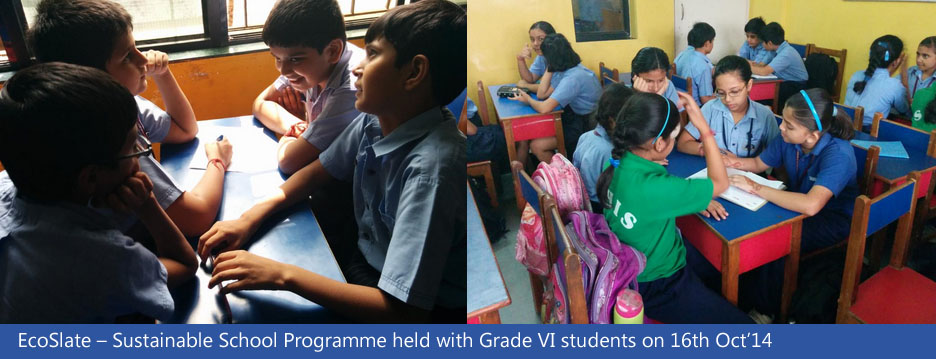
Objective:
To help the students understand the social injustice with respect to food that exists in our society.
Class Plan I: Worksheet Discussion
- All students were divided into groups of different sizes.
- Each group was given a budget in terms of rupees per person per day using which each group had to design a 3 meal menu for a day – breakfast, lunch and dinner
- In round 1, the budget given to them represented upper and upper middle class segment of the society
- In round 2, students were given the budget representing economically lower segment of the society and each group was asked to repeat the same exercise of designing a 3 meal menu for a day
- This simulation helped students understand the social injustice that exists in the society
- It was discussed with the students how food is a common resource and should be equally available to all. However, due to one reason or the other, there is lack of equal distribution of food thereby leading to social injustice in the society
- Students were involved in a discussion about how as an individual one can contribute in bridging this gap
Home exercise:
Students have been given a worksheet under which they have to record their meals for a period of 7 days. In the worksheet, the students have to also record how much food is wasted during each meal
Session Report (Sanitation): Class VI
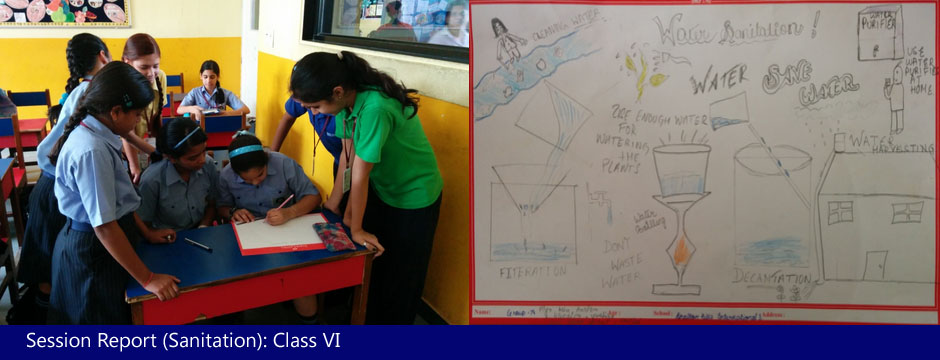
Objective:
To help students understand the value of healthy sanitation habits w.r.t waste and water
Class Plan I: An Art Story
- The class started with an introductory discussion on the meaning of the word sanitation and how important it is to maintain and follow basic hygiene
- All students were divided into groups and each group was given a drawing sheet and a set of colours
- All students in the group were numbered from 1 to X (‘ 10’ being the number of students in the group)
- 2 groups were given the theme of Water Sanitation while 2 groups were given the theme of Waste Management./li>
- The students with number 1 were asked to start drawing on the sheet given to each group on the theme given to the group./li>
- Once the first student finishes, the sheet was passed onto the second child. He/she had to now draw on the sheet something which needs to have a connection with what the first child has already drawn.
- The sheet keeps passing to all the students in the sequential order until all students are covered.
- The students were then asked to sit in a group and give a slogan to the picture drawn by them.
- These picture will now be used on the school’s notice board to spread awareness amongst other students in the school.
Class Plan II: Role Play
- he class started with an introductory discussion on the meaning of the word sanitation and how important it is to maintain and follow basic hygiene
- Students were divided into groups and each group was given a situation in which they had to perform a role play
- The first situation was about an old gentleman who was taking a walk in the park and he throws some garbage on the grass. Two young boys watch him doing that and decide to go and speak to him about the situation
- The second situation was about a house maid and how she uses huge amount of water for all household work. The lady in the house had to convince the maid to use water more judiciously
- Both the acts were recorded and will be used to spread awareness among the other students in the school
Students of Grade VII involved in Revamping of Vermipits as part of Waste management project on 30th September 2014

Mr. Rohit from Ecoslate along with Smarter Dharma – Knowledge provider (Bangalore based company) is collaborating with our school for revamping of our vermipits. Currently we are putting the dry leaves in the vermipits. The school team met the canteen in-charge to find out the exact amount of kitchen waste generated per day. As reported by them, around 8 to 10 kgs of kitchen waste is generated per day. Accordingly the following action plan was chalked out and implemented by Class VII students who are a part of the GSP team.
Background:
A good compost is primarily about maintaining healthy carbon to nitrogen ratio. While nitrogen comes from the food scraps, carbon rich matter includes branches, stems, dried leaves etc. A healthy compost pile should have much more carbon than nitrogen. Too much nitrogen makes for a dense, smelly, slowly decomposing anaerobic mass. Good composting hygiene means covering fresh nitrogen rich material, which can release odors if exposed to open air, with carbon rich material, which often exudes a fresh, wonderful smell. If in doubt, always add more carbon.
Step-by-Step Process:
- Our school generates around 8-10 kg of food waste daily, for that the ideal pit dimensions should be: 1-1.5 ft deep and 5-6 ft in length.
- We will divide the pit further into different horizontal sections.
- Following items ready in two different containers:
a. The first container will have dry leaves, branches or any other plant material. This should include dead or diseased plant material. This will contribute our carbon in the compost
b. The second container will have all the food waste. Ideally, this should be more of pre-cooked food, left over etc. Cooked food should be as less as possible
c. Ideally, the weight of both containers should be equal
STEPS INVOLVED : - Chop as finely as possible all the material present in the two containers
- Create a layer of dry leaves first
- Sprinkle small quantity of water
- Next, create a layer of your food waste
- Over it, create another layer of dry leaves or plant material
- Sprinkle some water
- Over it create a layer of soil
- Sprinkle some water
- Cover the pit with another layer of dry leaves
- Sprinkle some water over the top layer
Once, this is done we can keep adding food waste over it daily with alternate layers of dry plant material and soil. Keep sprinkling water to keep the compost moist.
As and when one portion of the pit gets full, we can move on the next portion.
A very important part of maintaining a good compost pit is to rotate all the material at least once a week. This ensures mixing of all material and availability of oxygen in adequate quantities.
Class VII children will take up the responsibility of doing the same in their GSP session.
Shalom Hills International School connects with Queenwood School, London for a common GSP programme

DATE: 7th September 2014
Good work surely has no boundaries and Shalom Hills International School has taken a laudable lead in reaching out to like-minded schools and through its green crusade create a commonwealth of green schools across the globe.
Shalom Hills International School has reached out to many schools in England through British Council’s world recognized and acclaimed Connect Classroom Programme. As part of its maiden launch, a Memorandum of Understanding has been signed between Queenswood School, London and Shalom Hills to join forces and jointly work on the Green School Programme. During this nascent stage, a common project space has been created on British Council website. The students of both the school are now working on elements of biodiversity. The following sub topics have been finalized as being the key components of the maiden part of project -
- Web of life- Food chain game
- Butterfly story to understand how climate change is effecting our biodiversity
- Reason for loss of biodiversity
- Audit of biodiversity element of school
- Developing biodiversity reports
- Making a difference
Session Report (Module 3): Class VI
Sustainable School Program
Objective:
To work with students to create a photo story involving the various biodiversity elements present in the school.
Class Plan I: Worksheet Discussion
- Worksheet 1 which involved interviewing the parent to understand if there is any visible difference in the biodiversity elements was discussed with the students
- 100% students had an observation that with respect to plant species, there is a clear distinction between plant species which existed when their parents were young and now
- Parents observed a number of native species near their homes including mango, neem, banyan tree etc. In the urban set-up of Gurgaon, such species are clearly absent
- With respect to animal species, students had a mixed observation
- There were a number of species such as sparrow, peacock, parrot which they do not observe very frequently now compared to 10-15 years ago
- Some common species such as crow, pigeon and dogs are still seen today coexisting with the urban dwellers
- 100% students observed that growing urbanization is the key reason behind absence of species
Class Plan II: Bio-Diversity Connect – A Photo Story
- Students were asked to assemble in a playground
- All students were divided into groups of 4 or 5
- All groups were then allocated a specific area in the playground
- All groups were given 5 minutes to think of a situation or a story which can be depicted through static poses. The only condition was that the students had to involve the various bio-diversity elements present around them
- One class was involved in creating a series of sequential events which created a story when pieced together. The story is attached in a separate presentation
Home exercise:
Students have to click one picture which should include them along with a plant or a pet animal in their home.
View Presentation

Ecoslate Green School Programme conducted on 2nd September 2014

SUBJECT: Ecoslate Green School Programme
Topic : Water Consumption
Class : VII
DATE: 2nd September 2014
Objective:
To help students the amount of water consumed in our household and how certain external factors such as population rise OR increase in pollution levels can impact their consumption
Class Plan:
- All students were divided in groups of 4.
- Each group represented one family and they were asked to list down all activities in their household that consumes water
- All groups were then given a number in terms of total litres of water available to them per day. The groups were asked to allocate the amount of water used for all activities as listed by them keeping the total water consumption at the number which was allotted to them in the beginning
- We then ran a series of simulations and introduced a number of external factors such as population rise, water table depletion, increase in levels of water pollution etc to understand how the amount of water consumed by each family would change. More importantly, how it would impact the lifestyle of all members in the family
- To conclude, students were presented with the case study of water situation in the city of Gurgaon. Several facts were presented such as total water available for Gurgaon, current per capita consumption, projected per capita consumption etc
The students have been given 2 worksheets. In the first one, they need to select 1 river out of Ganga and Yamuna and track its complete path. Within this path, students have to identify the points of no pollution, moderate pollution and heavy pollution.
In the second worksheet, students have to perform the water audit of their homes and make a plan in consultation with their parents to optimize the amount of water consumed in their homes.
A workshop as part of Ecoslate Green School Programme conducted in Grade VI on 2nd September’14

Topic : Biodiversity
A GSP workshop by Eco Slate was conducted with the objective:
To help students understand that our consumption impacts the biodiversity around us and it is therefore important for us to become responsible consumers and choose products which are natural and do not impact our biodiversity
Class Plan:
- The class started with a recap of key learnings from the previous session
- The students were then involved in a simple mathematical simulation exercise wherein they had to find out the total paper used by them in one year in the form of their notebooks, books, newspapers, almanac, drawing book etc
- The exercise was then extended to a point wherein the students had to calculate the total paper consumed by the entire class VI in 1 year
- These numbers were then linked to the number of trees being cut and the amount of forest area being cleared because of their usage of paper in the school
- Through a web of life activity conducted in last sessions, the students were asked to link cutting of trees with the impact on other elements of the biodiversity
- The students were then made to understand through this simulation how their consumption patterns are impacting the biodiversity around us
- A case of Palm Oil consumption and the subsequent deterioration of rainforests in Malaysia and Indonesia was presented to the students which completely shocked them
Waste Management activities carried out in Grades VI-VIII & XI on 30th July’14
Every activity is carried out in Shalom Hills International School with a purpose of making learning take place in a fun-filled and creative manner. With this aim in mind, a Pilot Project based on Waste Management was conducted for Grade VI, VII, VIII and IX. Disposing of waste in an environmentally friendly manner is one of the most sensitive issues in today’s time. The students prepared attractive looking dust bins using card board, decorative material and disposable bags displaying their creative instinct with zeal and vigour. They were brimming with enthusiasm and were explained the purpose and use of the hand- made trash bins made by them. They were briefed about the ways in which human activities leave a deep impact in producing waste which affect human health. Therefore, to help our environment stay clean and healthy, various measures should be carried out for the benefit of mankind.
Keeping our school’s Green School Pilot Project in mind, a visit was conducted by one of the members of Eco Slate, Mr. Rohit Prakash to help the students to have a better understanding of Waste Management. Our students showed keen interest and shared their various doubts. He appreciated the hard work and efficiency of the students’ involvement in this project. He explained to them the meaning of recycle which is a form of resource recovery practice which refers to reuse of waste materials. He furthermore, explained about biological reprocessing, spreading awareness about how food scraps and paper products could be recovered through composting. He explained various measures of disposal methods which boosted our general awareness. However, it was indeed a proud moment when the students were informed that our school is the first probably around NCR and probably Delhi to initiate this Pilot Project of Waste Management.
The resource person was indeed ecstatic to witness the scientific minds of our students and their optimistic approach to make this Project a success. The collaborative and conscientious efforts of our Shalomites were clearly visible as they took firm steps to save the environment!
Drip Irrigation Project
ACTIVITY: How to conserve water using drip irrigation technique?
CLASS: VI D
In continuation to the work done previously in the area of Drip Irrigation, on 22nd July’14 the students of Grade VI D, under the guidance of their Science teacher, Ms Anjali Drolia did an activity by watering the plants in the kitchen garden area. The students were sensitized about the whys and how of the project and why they need to water the plants regularly. The students have adopted trees in the kitchen garden area and ensure regular water supply is available to the plants by way of drip irrigation.
Pre-Primary students of M I- M III celebrate Van Mahotsava
Van Mahotsava is an annual tree-planting festival in India, celebrated in the month of July.
This movement was initiated in the year 1950 by India's then Union Minister for Agriculture, Dr. K. M Munshi. Since then, the festival has gained immense national importance and every year, millions of saplings are planted all across India in observation of the Van Mahotsav week.
The Pre-Primary students at Shalom Hills School (Sushant Lok) celebrated the week in the school from 7th July-11th July’14 with great enthusiasm and keenness to do their bit for Mother Earth. With their tiny hands, the little ones planted life inside the soil as they planted seeds of different vegetables. This was not just one-act responsibility or lip service in name of tree plantation. Each class has taken its responsibility towards tree-plantation further on by adopting each seed/sapling. Every class is now taking care of each plantation by nurturing them with water and manure.
The children displayed the art & craft work created by them from recycled material and discarded items. A ‘Best from Waste’ corner was created in every class to display such art work.
As part of the festivities, one day, the students came dressed up in green coloured attires along with the staff members. All joined in the celebrations going on in the garden area.
The festival engendered in the students’ minds and hearts an awareness of the need of planting saplings and importance of tending to trees, as trees are one of the best ways to prevent global warming and reduce pollution. Hurrah to all the babies of M I- M III as they joined hands to celebrate Van Mahotsava as a festival of life!
Skit performed as part of Van Mahotsav celebrations
In Shalom Hills School, the Van Mahotsav celebrations were not only limited to the plantation of saplings but they also served as an effective means/day to spread awareness about social issues such as deforestation, soil erosion, increase in pollution levels, conservation and need to reduce & recycle. The students of MIII performed a skit based on all the above mentioned topics. Many students conveyed powerful social messages with such conviction that they impressed and inspired all their class mates and teachers alike.
Installation of drips in the school premises on 11th July’14
Mr. Sanjay Kaushik from NGO UTHAAN helped the students of our school in assembling drips while imparting to them technical inputs emphasizing the importance of drip irrigation and the quantity of water it can save.
The session started with a demonstration of the actual procedure of putting all the materials together and creating drips. The students enjoyed assembling the same with their own hands and took on the onus and ownership of the project upon themselves.
One drip near each plant was installed. The children happily wrote their names on their drips and vowed to themselves to implement the practice not only at their homes but also to spread awareness of the same in the community.
Drip Irrigation Project Stage 1: Collection of material for making drips done on 9th July’14
Shalom Hills International School believes in providing hands on experiential learning to the students which will help to bridge the gap between their theoretical and practical knowledge. In association with NGO UTHAAN, the school has taken up the drive to install drips at various places which will not only save water but also provide correct quantity of water to plants without unnecessary wastage.
And since any good work like charity begins at home or school, the students took up the initiative of putting drips in the school premise with great enthusiasm.
On the day of the maiden launch of the project, the children collected the pipes and other necessary material for the project.
Special Assembly on Van Mahotsav conducted in Class I-II on 9th July’14
Our school celebrated Van Mahotsava Week from 7th July till 9th July with great aplomb and enthusiasm. On day three i.e. 9th July, a Special Assembly was conducted in the Primary Wing by the children of Class-I-II to celebrate the same.
Class- II E commenced the assembly with the Lord’s Prayer followed by reading aloud of news headlines and the thought of the week. The little toddlers of Class- I showed their talent by way of a Group Song through which they expressed their love for Mother Earth and Nature in the most musical way possible.
Class II scholars came up with the innovative ideas on how to save nature and exhibited their talents and showcased them very creatively through a Role Play activity. Our little performers of Class II also demonstrated their environmental sensitivity through a gripping skit to show that the Environment should not be vitiated. The idea behind the activity to make the children sensitive towards nature and highlight the importance of planting more trees and protecting them.
Last but not the least a melodious performance was presented in the form of Earth Song. The students from each section of class –I and II participated in the same and exhibited their ideas to save nature.
Special Assembly on Van Mahotsav for Class III to V on 8th July’14
Environmental awareness is developed in the school children from the early years and every opportunity and occasion is utilized to engage them in tree-planting and other related environmental activities.
The students of Class III to V celebrated Vanmahotsav on 8th July in the Middle Wing Auditorium. As part of the three days celebration, numerous activities were organised to create awareness among the students for the conservation and preservation of our environment. The second day of this grand commemoration commenced with the Lord’s Prayer followed by the rendition of a beautiful and melodious song dedicated to our Mother Earth by the students of Class III. The energy and enthusiasm of these students set the mood for a skit on “Chipko Movement” organised by the students of Class IV. The skit highlighted the message that trees are our life saver and it is our duty and responsibility to save them.
Mrs. Rima Gaekwad, Junior Wing Headmistress reminded the students about their obligation to save the environment. It was a proud moment for the students when they applauded from the depths of their heart on learning about “The Most Sustainable School Award” for environment awareness which has been recently conferred on Shalom Hills.
Ms. Rima urged the students to maintain the school campus as a plastic free zone and to create a pollution free environment, thereby upholding a high quality of life. This disclosure was followed by a Role Play on “Plants and their significance in our Life” by the students of Class V. The students highlighted the different aspects of plant life and its contribution in our day to day life. This assembly showcased the commitment of the junior Shalomites towards a greener & cleaner world, with the hope that things will get better, and the world will be a better place to live. “Go Green and Save the Environment” - the pledge these junior students have adopted to create awareness about the environment and for its conservation.
Van Mahotsav activities carried out in Grades I-V on 7th July’14
Activities carried out – Colouring, Role Play, Collage making on Tree Plantation, PPT on Environment Sensitivity
Our school is celebrating Van Mahotsav from 7th July till 9th July with great aplomb and enthusiasm. Meaningful messages were put up all around the school and classrooms to highlight the importance of trees and how they are truly the 'Lifelines' and ‘Lungs’ of the earth. On 7th July, many activities were conducted in Primary Wing involving Grades I- V to celebrate the same.
The little ones of Class- I showed their talent and environmental consciousness by colouring a picture on the topic of ‘Save the environment’.
The young learners of Class II gave creative expression to their innovative ideas on how to protect nature from the onslaught of environmental degradation through the delightful activity of Role Play.
Our youthful scholars of Class III also translated their thoughts on how to stop environmental decimation on paper in the Collage Making activity. The children made cut outs of different trees and then pasted them on a chart paper. The idea behind this activity was to make the children sensitive towards deforestation. They understood the importance of planting more trees and protecting them. As they drew lifelike trees on paper and coloured them, they seem to have breathed green life into the beautiful collages.
Last but not the least, our think tank of Class IV and V also presented their ideas on how to preserve the earth through presentations. The students from each section of class –IV and V presented a PPT on diverse topics relating to environment sensitivity like Melting of Glaciers, Rise of Sea Level, Soil Erosion, and Global Warming etc. This was followed by an inspiring speech by Mrs. Rima Gaekwad, Headmistress - Middle Wing urging students to do their bit to prevent further desertification of the earth by each one planting a sapling.
‘Plant hope, plant a tree – Join the Van Mahotsav’
Green School Programme – Session on ‘water resources’ conducted with Grade VII students on 5th July’14
Objective:
1. To help the students to understand the demand and supply gap for a critical resource – water (case study: Gurgaon)
Class Plan:
1. Activity: First word in Your Mind – A very simple game in which one has to speak up the first word that comes to the mind upon hearing a word. The game started with the word water. The students mentioned various words but the one that stood out was LIFE.
2. In the Indian mythology, all our rivers were given the status of Goddesses. The reason was to not let humans pollute our rivers and to show them our respect. While we still continue to respect our rivers, somewhere that original association has vanished as people have turned our rivers into dumping ground for trash.
3. The average demand for water in the city of Gurgaon is approx. 184 million litres per day whereas the actual supply of water is roughly around 91 million litres per day. That is a staggering deficit of almost 50%. As the population of Gurgaon grows from current 25 lakhs to an estimated 40 lakhs in the near future, this problem is only going to increase.
4. It is important for the youth of today to understand exactly why this deficit exists and what can be done to minimize the same.
5. The students were involved in a round table discussion around how does the water from Yamuna flowing through 3 water treatment plants reaches our home. More facts were shared with the students regarding the leakage loss and how our consumption is shifting this balance further.
6. While there are some households in Gurgaon which consume an average of 224 litres of water per person per day, there are some whose average consumption is not even 50 litres of water per person per day. All the students discussed on this social injustice and whether it is healthy for our society.
Shalom Hills Sustainable Green School Programme Session with Grade VI students
Objective:
1. To introduce the meaning of bio-diversity and how it is important for our survival
2. To establish interconnectedness between different elements of bio-diversity
Class Plan:
1. The class started with an initial discussion on the meaning of bio-diversity
2. Activity: Web of Life – Every student is given a card mentioning one or the other element of bio-diversity such as sun, air, water, plants, trees, soil, different animal species etc. The child with the SUN card starts the game. The rule of the game is to tie a small piece of thread on one of the fingers and then pass it onto someone in the group with whom you have some relationship, whether direct or indirect. Since the students are sitting in random order, what they end up creating is a complex web with thread running in various directions.

At the end of the game, the students realize the importance of each and every element in bio-diversity. The idea behind creating this complex web is also to draw the attention of the children to the fact that even if one element in the bio-diversity is removed, it can create an impact on the humans whether directly or indirectly, whether in the short term or the long term.
3. The students were given a hypothetical situation of being required to survive in a closed room where all the basic amenities like food, water and air available to them. They were asked, for how long they think they can survive. It was observed that most of the students said that they may not want to live like this for more than a week.
This simple scenario clearly brought out the fact that even for us to be able to enjoy our lives; we need to be closer to the flora and fauna around us.
Home exercise:
All the students have been given a home exercise to take an interview of their parent and grandparent about different animal and plant species which existed when they were young and which they do not see now. The students will also probe their parent to find out probable reasons for the same.
| The students are required the register the response in the following format: | |||||
|---|---|---|---|---|---|
| S. No. | Name | Relationship | Which plant species they remember seeing when they were young that doesn’t exist now? | Which animal species they remember seeing when they were young that doesn’t exist now? | Why? |
What Next?
In the next class, the link between human consumption and the impact on bio-diversity will be established. This will be done through a case study on Palm Oil which is one the most common ingredients used in a number of household items. The excessive usage of Palm Oil is leading to a huge loss of our rainforests coupled with loss of many animal species including the cute and adorable Orangutan. The focus will also be on how an individual can optimize his /her consumption to reduce the pressure on our bio-diversity.
For more pictures, log onto facebook page at www.facebook.com/simplygreens













